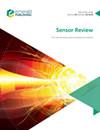基于氧化锌纳米棒的牛奶中三聚氰胺生态友好型传感器的实验评估
IF 1.6
4区 工程技术
Q3 INSTRUMENTS & INSTRUMENTATION
引用次数: 0
摘要
本研究的目的是开发一种简单易行的方法,用于制造一种能够在环境温度下检测牛奶中三聚氰胺含量的无毒金属氧化物传感器。设计/方法/途径利用一种低温、简单易行的基于溶液的方法,特别是水热法,将活性传感层涂在基底上。随后,对循环伏安法(CV)曲线进行了分析,以检测三聚氰胺的浓度并确定其灵敏度。研究结果对利用循环伏安法曲线制作的无毒金属氧化物传感器进行了实验分析,以检测三聚氰胺的灵敏度。在三种不同浓度的三聚氰胺(0.1 毫摩尔、0.2 毫摩尔和 0.3 毫摩尔)条件下对传感器的性能进行了评估。结果表明,该传感器的灵敏度为 0.0297 µAmM-1cm-2,响应时间为 2 秒,令人满意。与现有文献相比,所采用的合成方法大大降低了温度。此外,该传感器还具有更高的灵敏度和更快的响应时间。本文章由计算机程序翻译,如有差异,请以英文原文为准。
Experimental evaluation of ZnO nanorods based eco – friendly sensor for melamine detection in milk
Purpose
The purpose of this study is to develop a straightforward method for creating a non – toxic metal oxide sensor capable of detecting melamine in milk at ambient temperature.
Design/methodology/approach
A low temperature, straightforward solution-based approach, specifically the hydrothermal method was utilized to apply the active sensing layer onto the substrate. Subsequently, analysis of the cyclic voltammetry (CV) profile was conducted to detect the concentration of melamine and determine its sensitivity.
Findings
An experimental analysis was performed on a nontoxic metal oxide-based sensor fabricated for detecting melamine sensitivity using the CV profile. The sensor’s performance was evaluated under three different concentrations of melamine (0.1 mmol, 0.2 mmol and 0.3 mmol). The results demonstrated a satisfactory sensitivity of 0.0297 µAmM−1cm−2 with a response time of 2 s.
Originality/value
The primary innovation of this research lies in the creation of a nontoxic and environmentally friendly sensor. The synthesis method employed featured significantly lower temperatures compared to existing literatures. Furthermore, the sensor achieved enhanced sensitivity along with rapid response times.
求助全文
通过发布文献求助,成功后即可免费获取论文全文。
去求助
来源期刊

Sensor Review
工程技术-仪器仪表
CiteScore
3.40
自引率
6.20%
发文量
50
审稿时长
3.7 months
期刊介绍:
Sensor Review publishes peer reviewed state-of-the-art articles and specially commissioned technology reviews. Each issue of this multidisciplinary journal includes high quality original content covering all aspects of sensors and their applications, and reflecting the most interesting and strategically important research and development activities from around the world. Because of this, readers can stay at the very forefront of high technology sensor developments.
Emphasis is placed on detailed independent regular and review articles identifying the full range of sensors currently available for specific applications, as well as highlighting those areas of technology showing great potential for the future. The journal encourages authors to consider the practical and social implications of their articles.
All articles undergo a rigorous double-blind peer review process which involves an initial assessment of suitability of an article for the journal followed by sending it to, at least two reviewers in the field if deemed suitable.
Sensor Review’s coverage includes, but is not restricted to:
Mechanical sensors – position, displacement, proximity, velocity, acceleration, vibration, force, torque, pressure, and flow sensors
Electric and magnetic sensors – resistance, inductive, capacitive, piezoelectric, eddy-current, electromagnetic, photoelectric, and thermoelectric sensors
Temperature sensors, infrared sensors, humidity sensors
Optical, electro-optical and fibre-optic sensors and systems, photonic sensors
Biosensors, wearable and implantable sensors and systems, immunosensors
Gas and chemical sensors and systems, polymer sensors
Acoustic and ultrasonic sensors
Haptic sensors and devices
Smart and intelligent sensors and systems
Nanosensors, NEMS, MEMS, and BioMEMS
Quantum sensors
Sensor systems: sensor data fusion, signals, processing and interfacing, signal conditioning.
 求助内容:
求助内容: 应助结果提醒方式:
应助结果提醒方式:


